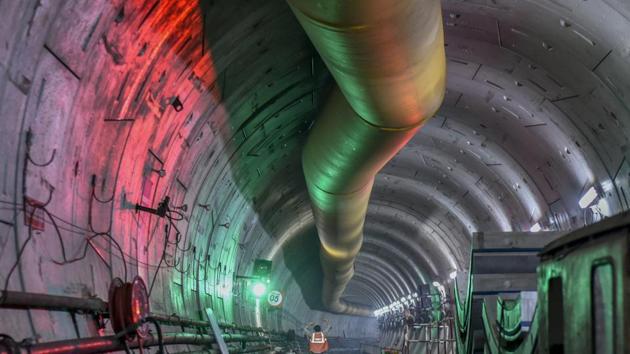Despite advantages of underground MRT, cities prefer a mix of elevated and underground Metros
While elevated lines cost less than a third of an underground network, savings in traffic congestion, pollution and maintenance make an underground system cheaper in the long run
Last week, the chief justice of Bombay high court, who was hearing a petition on the construction of a depot for the city’s first underground Metro line, said that cities worldwide did not build elevated lines. The judge said that the lines are either underground or over-ground.

While this is not true, studies have shown a public preference for an underground mass rail transit (MRT). A survey done as part of a study by Dr SL Dhingra of the Indian Institute of Technology, Bombay, on the comparative merits of underground and elevated MRT revealed that 90% of respondents living within 250 metres of the network preferred an underground system.
The study estimated that while an elevated system cost less than a third of an underground network and half of the cost on a partially underground line, savings in traffic congestion, pollution and maintenance made an underground system cheaper in the long run. MRT users said they were willing to pay two times the fares for an underground service. The study also said that an underground metro provided more social benefits and savings, including a reduction in land acquisition costs, doing away with the need to demolish and shifting of existing structures and utilities. The pilings for elevated railway lines can constrict traffic.
The study looked at the volume-to-capacity ratio of roads to calculate congestion and concluded that everywhere in Mumbai, especially in the city’s western suburbs, the MRT should go underground. “On the ground of constitutional right of equity and demand of users, UG (underground) metro proves to be the best alternative over EL (elevated) metro,” the study concluded.
“There is a case for every Metro to be underground, except in the outskirts of the city,” says Dhingra. “Underground costs four times the cost of an elevated route. Even taking this into account, the benefits of going underground is more. Elevated tracks take away at least one lane of the road on which it is built and during construction two or more lanes have to be barricaded, creating hell for people living around the route.”
Bombay high court, too, was worried about the extra maintenance costs of the infrastructure for an elevated line that is bound to have a limited life considering the extreme weather conditions in the city.
Despite the advantages of an underground metro, cities across the world have a mix of underground, over-ground and elevated tracks.
Apart from the lower cost of construction, elevated lines require less electricity for cooling and lighting. Cities across the world have a preference for elevated MRTs.
Bangkok, a latecomer to MRT, runs an elevated rail system, called the BTS Skytrain. When the system was proposed, there was opposition, including concerns that the elevated tracks will mar the city’s landscape and cause traffic jams underneath. The rail system has been so successful that the city is planning 10 more lines, some of it underground but most of it on elevated tracks. Similar systems are being planned in Thailand’s smaller cities.
New York City and Berlin have metro systems that are a mix of underground and elevated. The Dubai metro is elevated. Singapore MRT runs mostly underground in the city centre but is elevated in the less congested outskirts. Only 45% of London’s 400-km system runs underground though the network is called the ‘underground’ or the ‘tube’.
In Delhi, which has the country’s biggest Metro system, most of the track is elevated. In the third phase that is under construction, only 40% of the track is underground. When the last of the currently planned phases are completed, less than a fourth of the entire network will be underground. The Metro systems in Jaipur, Hyderabad, Bengaluru, at least the lines that are under operation, are all elevated. Though the country’s first Metro system – in Kolkata – built its first line partly underground, new lines will also be elevated and ground-level.
Stay updated with all the Breaking News and Latest News from Mumbai. Click here for comprehensive coverage of top Cities including Bengaluru, Delhi, Hyderabad, and more across India along with Stay informed on the latest happenings in World News.
Stay updated with all the Breaking News and Latest News from Mumbai. Click here for comprehensive coverage of top Cities including Bengaluru, Delhi, Hyderabad, and more across India along with Stay informed on the latest happenings in World News.






